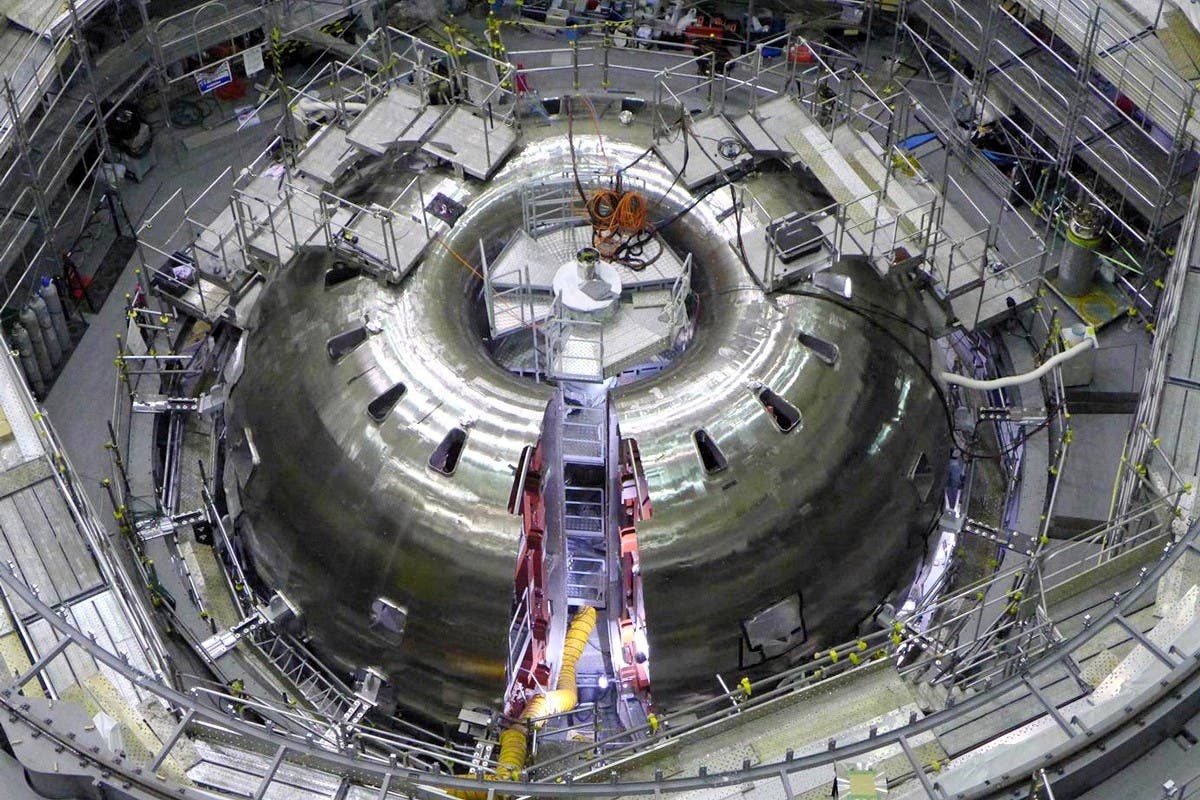The scientists used lasers to fuse two light atoms into a single one, releasing 3.15MJ (megajoules) of energy from 2.05MJ of input – roughly enough to boil a kettle.
Why do we even study this? Renewables are the only way. This is a waste of money which is a finite resource.

So 1. This is newable. Green, almost waste free, and unlimited.
If we can refine fusion, we will stop global warming and energy insecurity, virtually overnight.
It’s not a waste to invest in clean tech R&D. At one point, people said the same thing about solar, and look where we are now

While this is exciting and there are many reasons to continue to research fusion, fighting climate change is very much not one of them. It has all of the real problems of fission, namely high cost, low scale, and difficult construction, but exacerbated to an extreme degree. If new fission projects struggle to get investor funding becuse of low profitability and difficult construction times dispite nearly a century of development, it is unlikely that a technology so complex and expensive that we don’t even had a plan for a power plant yet will do better.
We might have a fusion pathfinder plant by 2050 or 2060, we need to be off fossil fuel by 2030 to 2035. We might be able to built sufficient fission by then if we started now at scale, national average construction times tend to be between 5 to 10 years, but fusion is a tool that might at best replace the power plants we build today, not the coal and natural gas plants we built yesterday.
I bring this up not because I oppose funding fusion and pure science, but because any argument that calls it an answer to climate change is going to fall apart the second you consider any alternative on a cost or time basis.

Fission requires insanely costly wastes management. It is very dangerous and security is a huge costs-contributing factor. This is not the case with fusion, so costs might be lower despite complexity.

Fusion also produces most of the nuclear waste that a fission plant does thanks to undergoing the same nutron activation process, and while it lacks spent fuel rods, thouse are already infinitely recyclable, so the only real waste saveings would be in low grade waste like dust covered clean suits and such.
This also doesn’t help the case for Fusion very much given that even with these disposal costs ITER has costs four to six times any average fission plant for a donor reactor that has no generating capacity and which is mearly to prove that the physics work, something we did for fission with the Chicago pile in 1942 at an estimated inflation adjusted cost of 53 million dollars.
If it’s this expensive for a proof of concept, it is very unlikely that any full plant would be much cheaper. Compare it to things we can actually deploy at scale today like onshore wind or battery backed solar, and it is pretty clear that Fusion is an expensive but important science project, not a serious proposal to power the electrical grid.

Why do you have multiple post of breakthroughs in nuclear tech with negative criticism?
In fact multiple posts appearing to concern troll renewables with statements like “coal is here to stay”??

Because they’re all solar punk enthusiasts. Basically modern day hippies but without the common sense.
They really really like renewable energy but they don’t have a clue what they’re talking about so anytime anyone comes up with anything that isn’t solar panels or wind turbines they throw a fit.
Id you’re going to judge me on my post history, then read ALL of them.
Creep

Post history is public, why would it make you a creep?
is it not creepy to photograph children in a public park?
just because things are in the public, doesn’t mean what’s happening is not creepy

It’s more comparable to the past things an author has written as opinion pieces.
It’s your own choice to post on a public forum.
imagine I’m reading through all of your comments and posts for the next hour or so of my life. all of my thoughts are centered on you. what you think, how you articulate, your sense of humor, what memes you like, everything you’ve made public. it’s creepy.

Um, no, it’s not. That’s why it’s public. Feel free to read mine, if you want to waste your time.

I don’t care lol
The very reason I post things on Lemmy is so that people read them.
your post count is zero, my lemmy

See that can be solved as easily as just not putting that information publicly online.
If you make information public then someone is going to read it. That’s generally how that works.

Oh uh uh mate. I was happy to not reply but as others have pointed out I noticed by seeing multiple posts with your username in all. I then checked your post history to confirm my suspicion.
Your commenting history is public by design, it was programmed that way, for the very reason I used it. So someone can see if a poster has history of posting bad faith shit. The fact that you’re trying the whole “creep” angle means you’re intentionally being disingenuous about it or have no idea how the internet has worked since forums.
you’re such an intelligent person, why engage?

A sad reply but I’m glad to see you’ve given up the pretending. Your post, the replies and the downvotes are probably cause for some introspection, though given this reply you don’t strike me as the type. Have a good one.
Only your hatred can destroy me

All renewable energy comes from the sun, which is a giant fusion reactor. Seems like it might be a good idea to study and understand the concept.

Yeah, fusion is about the longest lasting power source in the entire universe. It quite literally is what the entire universe runs on. Without fusion, there would have been no stars. The universe would be dead.

If it’s not geothermal or nuclear, that energy probably came from the sun one way or another.
it’s so expensive though

The benefits of nuclear fusion could eventually power the world for everyone for free with no greenhouse gasses. Of course RnD is expensive, but that doesn’t mean it’s not worth it

Is it though? 560Mil is like 5 F35 jets

We gave away for more than that on covid scams. That we will never recover. Collect the correct amount of tax from a few companies/individuals and we could build 10 of these.

It’s not like we are about to run out of it.
Money is essentially time and that is finite but money allows to composite time by combining the time of many into one single task.
Scientific endeavour is of the few meritous causes where money should never be an issue.

In order to get the energy output of a fusion reactor with renewables you would have to have millions and millions of solar panels you don’t think that’s expensive?

Money is neither finite nor a resource

Exactly.
(It’s made up, can be changed, value is what is agreed upon)

Not without consequences (inflation, etc)

You’re kind of a lame dude. Piss off.

Renewables are the only way.
You’re right! We should power everything by burning charcoal.

Some downvotes I saw, I am not sure if people can tell sarcasm.

I wasn’t being sarcastic at all. OP wants renewables, and charcoal is renewable.

Well call me a dumbasses for thinking that was sarcasm. Charcoal is not renewable bro. Wtf.

It absolutely is. Charcoal comes from wood. You can plant more trees. Renewable.

Right and we already have amazing track record on reforestation, and our rainforest are healthier than ever.

You’re not even citing the right reactor. LLNL did that experiment, this reactor in Japan is to try to scale it.

There’s a difference between what works best now to meet our energy needs (renewables) and the furthering of the science behind nuclear technology. We can do both.

This is a 100%+ efficiency reactor with the capacity to basically make itself run all on its own with automation. How many electrical generators can run on their own 24/7?

Morpheus, holding up a AA: “7 billion”
This is the best summary I could come up with:
The world’s biggest nuclear fusion reactor has begun operations in Japan, marking a major milestone towards achieving the “holy grail” of clean energy.
The experimental JT-60SA reactor in Japan’s Ibaraki Prefecture offers the best opportunity yet to test nuclear fusion as a sustainable and near limitless power source.
The opening of the JT-60SA reactor comes just one year after scientists at the Lawrence Livermore National Laboratory in California achieved a net energy gain with nuclear fusion for the first time.
Physicist Arthur Turrell, who was not involved in the research, described the achievement of nuclear fusion ignition as “a moment of history” that could define a new era of energy.
“This experimental result will electrify efforts to eventually power the planet with nuclear fusion – at a time when we’ve never needed a plentiful source of carbon-free energy more.”
One of the main objectives for the newly opened reactor, which measures six stories in height, is to replicate the feat of producing a net surplus of energy.
The original article contains 419 words, the summary contains 167 words. Saved 60%. I’m a bot and I’m open source!

The current energy consumption of the planet is 113,000Twh (according to Wikipedia). Since every single Joule of renewable energy is some derivative of solar energy (solar, wind, tide, hydro, but not geo I suppose) the maximum energy we can derive from renewables is 765,000Twh.
The problem with that, is if we start to consume 10’s of percent of the total solar radiation through “renewables” that would otherwise go into generating weather and other natural events, well I’m sure you can see the potential problems.
So, we have to get away from carbon intensive electricity generation, but we can’t physically rely solely on renewables. Therefore we need fission/fusion.
There’s obviously the case of our current economic system causing us to overuse energy in the name of profit (oil is so important because it makes energy cheap and thus easier to make profits), and a change in production/consumption/distribution priorities would likely cause huge decreases in energy needs globally. But we can only really consider energy needs based on what we know.
Whoops, I forgot the “achtually”.

I’ve seen enough anime to know that turning on the experimental fusion reactor in some Japanese prefecture is an event that doesn’t end well.

OK - let’s ignore the shitshow of responding to OP’s hot take.
What kind of research is this particular reactor going to do?

